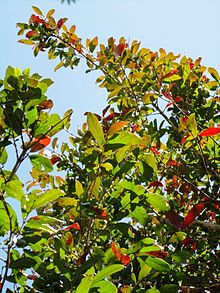| Forest bushwillow | |
|---|---|

| |
| C. kraussii winter foliage | |
| Conservation status | |
 Least Concern (IUCN 3.1) | |
| Scientific classification | |
| Kingdom: | Plantae |
| Clade: | Tracheophytes |
| Clade: | Angiosperms |
| Clade: | Eudicots |
| Clade: | Rosids |
| Order: | Myrtales |
| Family: | Combretaceae |
| Genus: | Combretum |
| Species: | C. kraussii |
| Binomial name | |
| Combretum kraussii Hochst. | |
| Synonyms | |
| |
Combretum kraussii, the forest bushwillow, is a medium-sized to large tree in the family Combretaceae. It is found in eastern South Africa, Eswatini and southern Mozambique, in the vicinity of forests. The specific name commemorates Dr. F. Krauss who undertook a collecting trip to South Africa from 1838 to 1840.
Description
The trees are semi-deciduous, as spring leaves only partially replace old foliage. These forest trees become conspicuous in late spring, when the fresh leaves turn to a pale, almost white colour, before returning to green by mid-summer. In winter the foliage turns partially red or purple, which is shed just before flowering starts. The fresh clusters of four-winged fruit are a colourful red or yellowy red colour, before they dry to mid-brown.
Biochemical
Combretastatin B-1, a type of stilbenoid, can be found in C. kraussii.
Relationships
It is closely related to Combretum nelsonii which occurs in rockier habitats, and bears a resemblance to the larger leaved Combretum woodii, which is similarly distributed, but in bushveld.
Gallery
References
- Botanic Gardens Conservation International (BGCI) & IUCN SSC Global Tree Specialist Group (2021). "Combretum kraussii". IUCN Red List of Threatened Species. 2021: e.T146456269A208438144. doi:10.2305/IUCN.UK.2021-3.RLTS.T146456269A208438144.en. Retrieved December 13, 2024.
- ^ "Combretum kraussii Hochst". Plants of the World Online. The Trustees of the Royal Botanic Gardens, Kew. n.d. Retrieved December 13, 2024.
- ^ Le Roux, Lou-Nita; et al. "Combretum kraussii". Retrieved 14 October 2011.
- "Combretum kraussii Hochst". Catalogue of Life. Species 2000. n.d. Retrieved December 13, 2024.
- ^ Van Wyk, Braam, Piet (1997). Field Guide to the Trees of Southern Africa. Cape Town: Struik. p. 332. ISBN 1-86825-922-6.
{{cite book}}: CS1 maint: multiple names: authors list (link) - ^ Palgrave, K.C. (1984). Trees of Southern Africa. Cape Town: Struik. p. 670. ISBN 0-86977-081-0.
- ^ Pooley, Elsa (1997). The Complete Field Guide to Trees of Natal, Zululand & Transkei. Durban: Natal Flora Publications Trust. p. 358. ISBN 0-620-17697-0.
- Uteroactive constituents from Combretum kraussii. Bridget K Brookes, Olga V Doudoukina, Lynn C Katsoulis and Joy H D Veale, South African Journal of Chemistry, Dec 99, Vol. 52, Issue 4, page 127 (abstract)
| Taxon identifiers | |
|---|---|
| Combretum kraussii |
|



